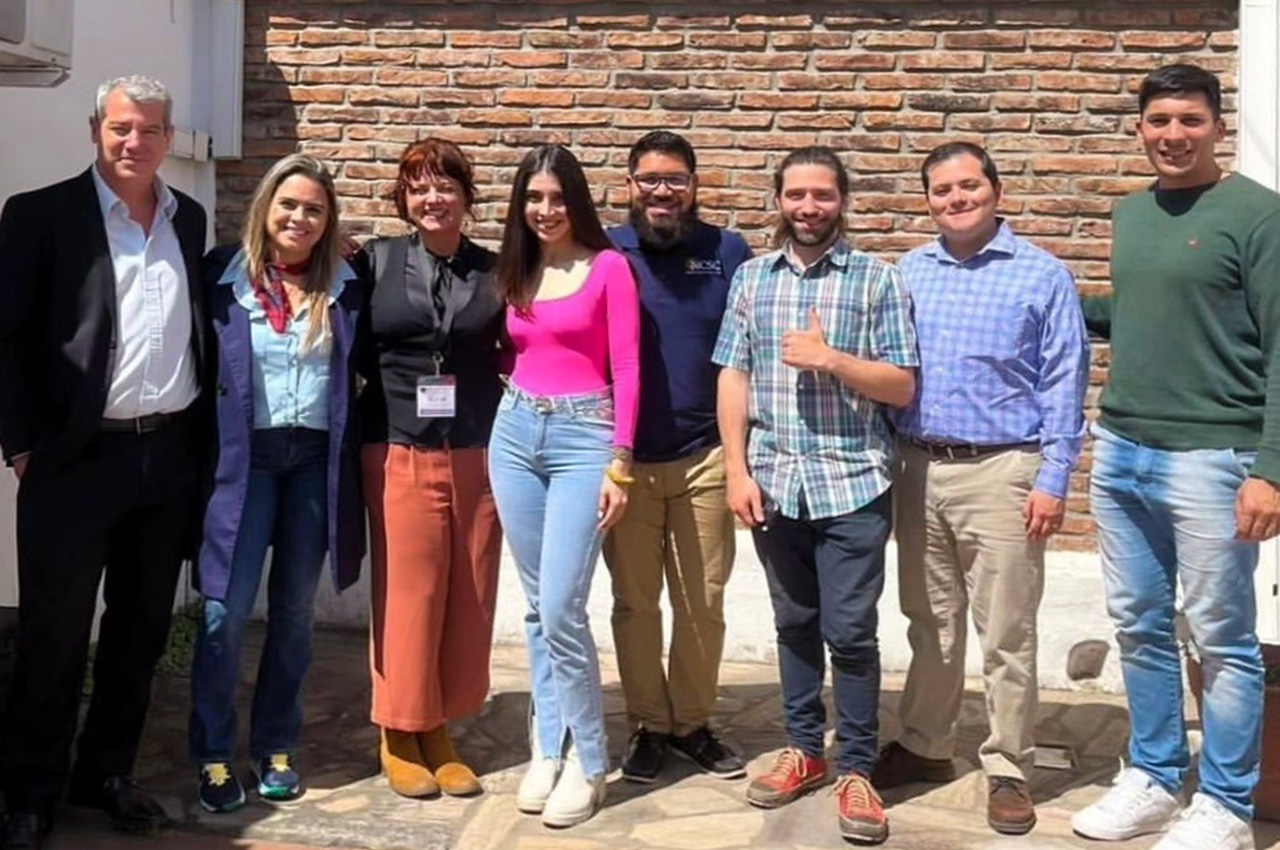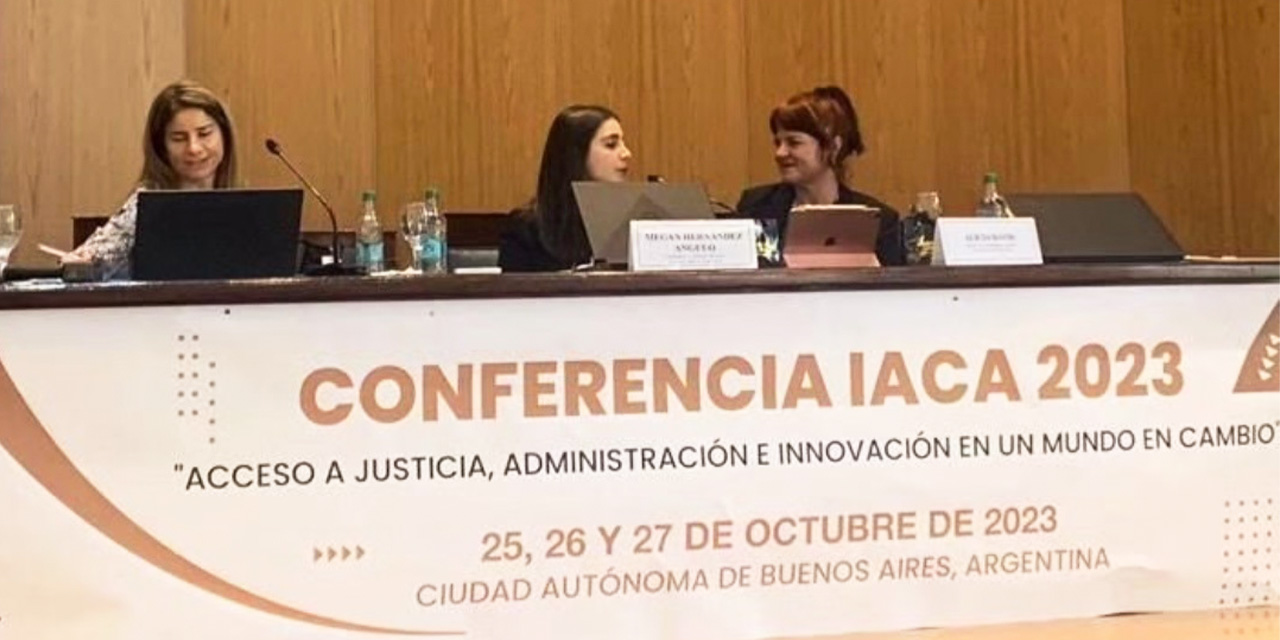We had the great pleasure of attending the annual conference of the International Association for Court Administration (IACA) in beautiful Buenos Aires, Argentina, October 25-27 last year. As in previous years, the IACA Conference themes are timely and universal in court application. The theme Access to Justice, Administration, and Innovation in a Changing World held particular interest.
Technology holds great promise in increasing access to justice. Our session, “Empowering Survivors through Technology: A New Frontier in Addressing Gender-Based Violence,” discussed the increase in gender violence experienced worldwide during the pandemic, as well as the increase in the use of technology to further access to justice. The session presented examples of the transformative potential of technology in supporting survivors but focused on the crucial need to ensure a user-centered approach when designing such technologies.

Access to Justice, Administration, and Innovation
Attended by court administrators from around the world, the conference presented diverse themes centered on enhancing justice systems. Breakout sessions covered topics like community engagement in Georgia, showcasing how creating court community engagement plans and emphasizing procedural justice can advance people-centered justice. Another notable session discussed restorative justice in consumer relations in Buenos Aires, emphasizing the role of consumer protection in the justice system. The conference also explored digital transformation in Morocco’s justice ecosystem, highlighting the challenges and prospects of integrating technology into judicial processes. Another key theme was the independence and effectiveness of the judiciary, discussed in the context of various court administration models from different countries. These sessions underscored the ongoing efforts in judicial innovation, the importance of localizing justice initiatives, and the integration of technology in justice systems. A range of presentations provided insights into both technology and access to justice. Several sessions addressed data accuracy and public information in an age of misinformation. Other notable sessions on user-centered viewpoints included “Gender Perspective in the Judiciary of Canada” and “Problem Solving and Drug Treatment Courts in Colombia.” These discussions underscored the importance of human-centered and trauma-informed responses in working with vulnerable parties.
The Need for Human-Centered Design in Technology Responses to Gender-Based Violence
In considering the application of technology in providing access to those affected by gender violence, our session considered various technologies that could improve access to justice for parties affected by violence. However, we also acknowledged the limitations of technology and that technical solutions may not be appropriate for all populations or communities. Remote services bear risks. They can be less personal, especially for parties who have been subjected to significant trauma. The importance of balancing technological solutions with human-centered design was stressed. Moreover, when it comes to gender-based violence (GBV), we emphasized that understanding a specific community’s needs is essential before one begins to consider technological solutions. We reviewed a community-based service array assessment conducted in Costa Rica in 2022 to consider how a user-centered approach could, and should, be foundational to the development of any technologies. Human-centered design is always important in designing technological solutions, but particularly so for populations that may have experienced trauma and may still be at risk. Under these circumstances, it is more important than ever to consider if the presented technology can reduce procedural hurdles, accelerate the relief sought, protect party information, and not further traumatize parties.
Implementation Issues
In our session, we presented examples of some incredible and recent technologies, such as the Protection Order Portals in Indiana and Arizona. These have revolutionized obtaining protection orders for gender violence survivors.
Indiana’s portal has been recognized for enhancing access for English-language learners. The state, addressing evolving needs and technological advancements, has improved its civil protection order process, with an annual average of 35,000 new filings. Initially, Indiana’s 2015 statewide electronic filing system (EFS) excluded civil protection orders due to their sensitive content. Later, Indiana developed a dedicated Protection Order e-Filing Service Provider (EFSP) for these cases. This specialized EFSP, with features like form completion and document assembly, ensures security and efficiency specific to protection order cases.
Following the launch of Indiana’s statewide protection order registry, the state introduced “Advocate Access,” a module enhancing the process of filing for protection orders. This system allows advocates to assist survivors from various locations, including shelters and hospitals, by simplifying form completion and ensuring accuracy. It incorporates safety planning discussions and offers essential guidance on the implications of seeking a protection order. Advocates receive regular training for proficiency in the system. The module also supports automatic data entry into the protection order registry, streamlining the process and reducing clerical redundancies. A notable feature is the option for survivors to receive text or email notifications about key order developments, enhancing communication and support throughout the process.
Arizona’s Statewide Protective Order Project 2020, launched on January 1, 2020, includes the Court Protective Order Repository (CPOR) and AZPOINT, a protection order assembly technology. CPOR, managed by the Arizona Supreme Court, is a vital database for various protective orders, ensuring coordination with the national registry for protection orders. AZPOINT features accessible portals for petitions, clerks, and service. It offers a comprehensive petitioning process and provides resources for plaintiffs, including victim advocate contacts, case assistance, and safety planning. The platform emphasizes online security, featuring a quick logout safety button and private browsing instructions, along with detailed FAQs about protection orders and user support.
Like Indiana’s system, AZPOINT also allows parties to file from safe locations, including shelters. AZPOINT has reduced the amount of time for law enforcement agencies to report service of a protection order from 7 business days to 72 hours. The introduction of AZPOINT has had a significant positive effect on the number of protection orders filed. Overall, 35,000 protection orders and 15,000 injunctions against harassment are issued annually in the state. Currently, two-thirds of plaintiffs use AZPOINT to complete their paperwork. Though the remaining third of plaintiffs opt to complete their forms on paper, many of the benefits of AZPOINT still apply as paper forms are immediately scanned and uploaded to the system.
Both systems have accelerated time to receiving protection orders and have demonstrated increased access to justice by the increasing number of petitions filed through these portals. These states, along with Kansas, have been identified as Mentor Courts in a large-scale national technical assistance project through the U.S. Department of Justice, Office of Violence Against Women to develop and demonstrate national recommendations and guidance focused on improving access and safety in court technology for civil protection orders.
The Costa Rica Service Array Evaluation
We considered a recent study of service array conducted in Costa Rica during the pandemic to consider human-centered design and how this approach could inform the development of future technologies.
Costa Rica has historically been a progressive country, with a broad regulatory base for the protection of women’s rights and with a service array aimed at addressing violence against women. During the pandemic, Costa Rica, like many countries in the region, experienced an increase in GBV, due to long periods of confinement that often left the victim and perpetrator in the same home, along with a reduction in public services.
The purpose of this study was to evaluate the array and coordination of services for women affected by gender violence from a territorial and intersectional perspective. The study sought to consider the perspectives of women from various regions of the country who had been subjected to gender violence to determine the gaps that could occur due to geographic, ethnic, or social conditions. The study highlighted key findings from a user perspective.
First, the study emphasized the importance of comprehensive public policies for GBV prevention and care, noting the need for a coordinated approach. It highlighted the necessity of integrating efforts across various sectors, ensuring effective collaboration among governmental entities, NGOs, healthcare providers, and community organizations. The study pointed out that sustained funding and resource allocation are critical to support these coordinated efforts. By doing so, the study suggests a holistic approach to GBV prevention and care, ensuring that policies are inclusive, wide-ranging, and efficiently implemented.
Second, the study stressed the significance of localizing strategies and involving community actors in creating effective responses to GBV. This approach acknowledges that while national institutions might have protocols to assist GBV survivors, such support often fails to reach more remote or marginalized areas. Challenges such as geographical distance and a lack of culturally sensitive services for indigenous populations, women, girls, and adolescents are common in these areas. Therefore, the regionalization of GBV interventions is essential for making them relevant and accessible to all, regardless of their location or cultural background.
Third, involving civil society organizations (CSOs), which include nongovernmental organizations, community groups, nonprofits, and advocacy groups, is crucial for supporting GBV prevention and offering services. These organizations play a key role in advocating for policy changes, providing direct support to survivors, and raising public awareness about gender-based violence issues. Their grassroots approach ensures that efforts are culturally relevant and community focused, essential for effective intervention and support.
As Costa Rica continues to evaluate service array and technology to increase access to justice, we would offer these thoughts: a holistic service approach, integrating diverse technological solutions, is essential to meet the specific needs of GBV survivors across different regions. It is possible to offer information and services remotely, such as information on what constitutes intimate partner violence, where to receive financial support, or legal protection for abuse. However, to span the various regions and technological infrastructures, these services must be culturally sensitive and adaptable to the local environment. In regions with limited internet access, mobile solutions might be more effective than web-based platforms. Integrating technology with support services like counseling, legal aid, and shelters ensures a more responsive approach to GBV. It is possible to design services that entirely rely on mobile devices. Tailoring these technologies to local contexts requires collaborative efforts among government bodies, civil society organizations, and technology providers. It’s crucial to continue exploring and adapting technological solutions to meet the specific needs of different communities and survivors.
At the end of the session, a participant raised the question about practical strategies for implementing technology with limited resources. This often involves raising awareness and understanding of gender-based violence within the community. We explore the concept of Coordinated Community Response (CCR), an approach that engages diverse stakeholders, including law enforcement, legal professionals, social services, and community members, to collaboratively identify key community concerns. This is a necessary first step to ensure that interventions are specifically tailored to the needs of survivors within the community. This could include training local leaders, forming grassroots advocacy groups, and promoting a culture of zero tolerance toward gender-based violence. In these scenarios, technology can be a supportive tool, potentially through mobile applications for incident reporting or platforms for public education. However, the focus remains on utilizing local resources and strengths, with technology playing a supporting rather than primary role.

Recommendations
Reflecting on the conference and offering specific recommendations to a global community on enhancing technology to provide services for those affected by gender violence, we offer these recommendations.
Conducting Court Process Self-Assessments: This involves courts actively seeking feedback on current processes for supporting those affected by gender violence. By conducting thorough reviews of both virtual and physical court processes, courts can identify and address technological issues or ineffective practices. This requires collaboration with a broad range of stakeholders such as attorneys, survivor advocates, behavioral health providers, and family court judges for effective problem-solving and improvement strategies.
Expanding Language Access: Courts should strive to make information regarding processes more accessible and understandable. This includes translating materials into multiple languages and simplifying legal jargon. This effort will empower users with better knowledge of their options and rights, enhancing their ability to protect themselves and their children.
Focusing on User Experience: The implementation of new technologies in courts should be user-centric. This entails engaging directly with survivors and advocates from the beginning to ensure that technologies meet their needs effectively.
Conducting a Usability Analysis: This involves a systematic evaluation of how usable and effective the court’s technological solutions are. By observing and gathering feedback from actual users, including both court personnel and those seeking court services, the analysis can identify areas of confusion or difficulty. This process should ideally involve a diverse group of users to ensure that the technology is accessible and intuitive for everyone. The findings from this usability analysis can then guide refinements and enhancements to the court’s digital platforms, ensuring they are more aligned with the needs and expectations of their users.
These steps aim to create a more responsive and inclusive court system that prioritizes the needs and experiences of its users.
Conclusion
As we reflected on our participation at the conference, the imperative for user-centered legal practices became evident. The implementation of technology as a form of access to justice must start from an analysis that questions “where we are, what we have and what we want to achieve,” understanding that justice systems cannot transfer errors to technology that put the well-being of users at risk, especially when we are faced with situations as serious as GBV.
It was encouraging to hear in so many sessions the emphasis on the court user. The conference not only provided a platform for knowledge exchange but also inspired further work in this area.
These steps aim to create a more responsive and inclusive court system that prioritizes the needs and experiences of its users.
ABOUT THE AUTHORS
Alicia Davis is principal court management consultant, Court Consulting Services, Families, Children, and Behavioral Health, National Center for State Courts.
Megan Hernandez Angulo is attorney and program manager, National Center for State Courts, Costa Rica office.


